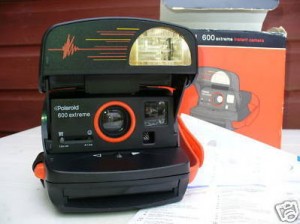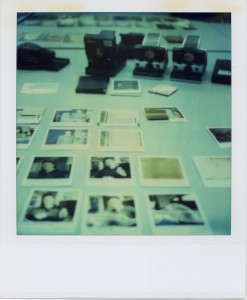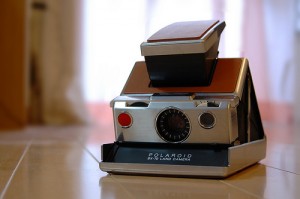 At the time of writing, I’m eagerly awaiting the arrival of my first ever Polaroid camera: the 600 Extreme that I got from eBay for a bargain price of £2.50. Hey, it even was for charity!
At the time of writing, I’m eagerly awaiting the arrival of my first ever Polaroid camera: the 600 Extreme that I got from eBay for a bargain price of £2.50. Hey, it even was for charity!
I wanted it because there’s an ever so slim chance that I can use it with the brand new film by The Impossible Project: PX100 First Flush. It’s a black and white film that fits old Polaroid cameras and has only been released a couple of weeks ago.
The Impossible Project, lead by Lomography founder Dr. Florian Kaps, have bought the last remaining Polaroid film factory in Enschede in 2008 and have since then been working on reviving this brilliant format. I cannot wait to see what they’ve come up with!
 Since Polaroid left about 300 million cameras stranded in drawers and attics around the world without fresh film coming onto the market, my fascination with a medium doomed to be extinct keeps growing daily. I never really cared for Polaroid in the past, mainly because of expensive running costs. The cameras aren’t exactly attractive either. However, my views on the subject have changed in recent years, and ever since I acquired an Instant Back for my Diana I don’t mind telling you that both Julia and I are ADDICTED to instant pictures!
Since Polaroid left about 300 million cameras stranded in drawers and attics around the world without fresh film coming onto the market, my fascination with a medium doomed to be extinct keeps growing daily. I never really cared for Polaroid in the past, mainly because of expensive running costs. The cameras aren’t exactly attractive either. However, my views on the subject have changed in recent years, and ever since I acquired an Instant Back for my Diana I don’t mind telling you that both Julia and I are ADDICTED to instant pictures!
With the arrival of the very first batch of newly produced PX100 film, my interest in Polaroid has skyrocketed. I had to see for myself what I could do with an overpriced and hard-to-get pack of 8 pictures for £20. Considering I haven’t got the right camera, this is bound to be an adventure…
First things first: The Polaroid Camera
When I began looking into this dark and spooky realm of photography, there’s one thing I always found very confusing about Polaroid: there are seemingly hundreds of different film formats for what appears to be only one camera. It’s as if you need a PhD in Polaroid and have to pay £1 for each picture. No wonder they went bust! I had to find out more. Feels like I’m snooping around in top secret Stasi files in Eastern Germany while uncovering these secrets…
Here’s the answer to the first hurdle: http://www.savepolaroid.com have a handy list of film formats – past and present. Looks like there’s more than one camera after all.

I remember we had a black brick Polaroid when I was a kid, and I also remember we hardly used it due to film costs. I must ask my Mum if it’s still floating around somewhere. What I have learnt now is that this would have been an Integral Series 600 camera (Integral meaning that both film and chemicals, as well as a battery to power the camera are all contained in the cartridge).
These cameras were Polaroid’s flagship seller during the 80’s/90’s and are most commonly associated with Polaroid when people talk about the format. The cameras have virtually been unchanged since the their introduction apart from colours and designs. They all contain
- a fairly cheap plastic lens with a focal lenth of 114mm (give or take)
- fixed focus
- fixed aperture of about f11
- a flash on the top
- and if you’re lucky they come with a close-up setting
Some models employ sonar autofocus and most of them fold into an ugly brick. All you can do is point-and-shoot – so it’s fairly amazing when you see the pictures people have created with it.
The new PX100 film however is made for SX-70 cameras… hm! What’s the difference I wonder?
SX-70 vs. 600 – Will it fit?

Well, the SX-70 was Polaroid’s very first integral camera and was introduced in 1972 (that’s when I was born – I feel a connection 😉 ). It was a folding SLR camera and caught the world by storm, despite a hefty price tag of $160 (that’s over $800 in today’s money). Several other models were made using the same type of film. Even though the resulting pictures have the same size (i.e. the trademark sqaure picture with a white border, slightly wider at the bottom – often used by criminals in spooky movies), there is a difference between SX-70 film and 600 film.
great post as usual!
Don’t Project Impossible make 600 film?
They do, but at the time I was testing the PX100, the PX600 it wasn’t available yet.
Great post! Like you, I’m getting into Polaroid photography too. The cost is insane, but it’s so much fun! (A Diana Instant Back was also my stepping stone to this madness)
would you know what filter would i get to put on the onestep 600 close up?
(where’s the filter???)
Same as the one I use for my Extreme 600 – it’s just a tiny piece of ND Gel from a filter swatch, enough to cover the “electric eye” next to the lens on the right. A piece of Quality Street wrapper would do the trick too (try the purple one) and get creative with some scotch tape.
Good luck!
Hi,
first of all, great post! I just discovered your website as I was looking for information concerning my new Polaroid 600 camera.
With this camera I bought a pack of 8 silver shade films and I was wondering, how can I get coloured pictures? With which types of films?
I read something about SX-70 films that might be compatible with the Polaroid 600, is that true? I see a lot of different opinions about that…
thanks in advance 🙂
Hi Charlotte,
the PX100 and PX600 films are black and white films (or rather sepia / rust colour films). PX 70 are the “colour” films – however they don’t work very well at the moment. Check out this article I’ve written for some examples of those pictures. Some uisers on the Impossible site are creating rather great results – but I haven’t managed to do so.
PX 70 is made for SX-70 cameras, but they do work in 600 cameras too. The only main difference is that 600 cameras by default would expose the film 2 stops lower than it needs to be, so just slide the slider to “lighter” and you’ll be fine. It’s still very much experimental.
Good luck with your Polaroid 😉
Thanks a lot, that’s what I figured out but I really wasn’t sure if it was correct! 🙂 Thanks again!
thank you for these great tips!
I looked on the impossible website and they have colour PX70 film but it states on there that it does NOT work in any 600 cameras, why is that?
My camera is on its way, I have order some b+w 600 film but want to experiment with PX70 🙂 x
The reason why Impossible say that PX70 doesn’t work in 600 cameras is because it needs a LOT of light to yield reults that can be described as “colour”. It will work but the pictures will look rather bad (like mine I guess – and they were taken with an SX 70 camera).
The main difference between 600 film and SX-70 film (like Impossible PX70) is that it’s less sensitive to light. SX-70 cameras use 100 ISO film, 600 cameras use 600 ISO film. The size is identical, and with Impossible film both cartridges are the same so they’ll fit either camera.
Have fun with your new Polaroid 600 😉
Hi there!
Ive just ordered some PX70 film for my 600. I’m not too bothered about the clarity as long as they are recognisable.
Are you saying I may need to protect them from light as they expose? Or did I make that up…
One of my 600’s has a slidey thing and the other doesn’t. Im getting myself confused now, Haha.
Great read though!
That’s right, you need to shield the picture from light when it comes out for about 3-4 minutes (no peeking). It’ll take a while for your pictures to come out completely, don’t be disappointed if you think they’re too dark and too blue – it’ll change in the first 30 minutes or so. The film comes with instructions that’ll explain this in more detail.
If you’re using PX 70 with your 600 camera, make sure you turn the exposure slider to dark all the way, or use an ND filter as described.
Happy shooting 😉